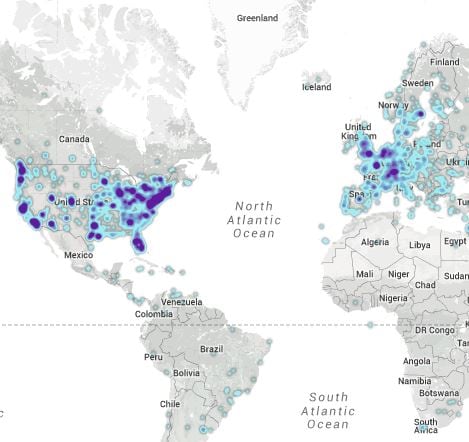
Data gathered by Bitnodes.io shows that the number of Bitcoin nodes is declining. Bitnodes is a data-driven website funded by the Bitcoin Foundation, and services to display a map of Bitcoin network nodes across the world.
The Bitcoin network depends on nodes (whether they are mining or not), which are servers which distribute the block chain, and provide the consensus over which order transactions were made. This ensuring of the order of transactions is the core of any crypto-currency’s security. Without an agreement on the order of Bitcoin transactions, transaction outputs (i.e. bitcoins) could be spent twice and the whole system would fall apart.
Bitnodes shows a heat map of the distribution of nodes across the world, which shows the greatest concentrations of nodes are in the USA and Europe. Furthermore, the top three countries are the United States, Germany, and the United Kingdom; in that order. There is a massive gap, however, between the first and second places. The United States has over 38% of the nodes, while both Germany and the United Kingdom have around 6% each (Canada is in fourth place with 5.9%). At the time of writing the total of active nodes were 8,087. There is also a 33% group of “other” (i.e. unknown) countries.
The cause for concern is when one looks at the 60 day chart of reachable nodes. There was a 19.3% drop from the 27th of February 2014 to the 27th of April 2014. At that rate, the number of nodes, and thus the Bitcoin network, would theoretically hit zero in 310 days (3rd January 2015). That will not happen, of course, as long as there are coins to be mined, there will be mining rigs out there to, by definition, act as nodes. However, the fewer nodes there are, transactions will eventually take longer as the remaining nodes will have to deal with more connections from Bitcoin clients.
Interestingly, the 60 day charts also show the trend of international distribution of Bitcoin nodes, and the share out of nodes has not significantly changed. All countries have scaled proportionately over the last 60 days.
These figures should be qualified, though. As discussed on the Bitcoin Forum, the figures only represent the nodes that the Bitnodes.io server could reach, and it cannot discern mining pools from single miners. Furthermore, there is no way to tell the difference between mining nodes and non-mining nodes.
Non-mining nodes are simply Bitcoin clients that carry a full copy of the block chain. Therefore, this drop in data could be interpreted in a number of ways. For example, this could count as a proliferation of “light” clients that do not carry the entire block chain, like wallet apps for mobile devices; or it could indicate a drop in Bitcoin participation. However, the volume of Bitcoin transactions has not significantly fallen, even though there has been a slight downward trend. Therefore, participation does not seem affected.
If you would like to create a Bitcoin node, you can find instructions on Reddit. This will involve downloading the 16GB block chain over Bittorrent, and configuring port forwarding on your router to make sure that the network can reach your Bitcoin client through your firewall.







